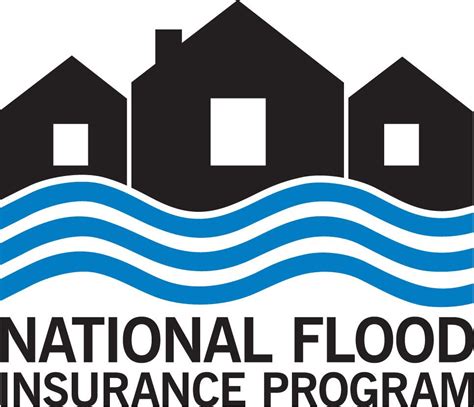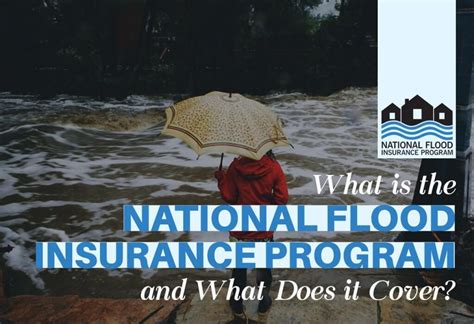National Floodplain Insurance Program

The National Floodplain Insurance Program (NFIP) is a crucial initiative aimed at mitigating the financial risks associated with flooding, one of the most common and costly natural disasters in the United States. Established in 1968 by the Congress, this program has played a pivotal role in providing much-needed flood insurance coverage to property owners and renters across the nation.
The NFIP has evolved significantly over the years, adapting to the changing landscape of flood risks and insurance needs. Today, it stands as a comprehensive and community-focused program, offering not only insurance but also valuable resources for flood risk management and mitigation.
This article delves deep into the intricacies of the National Floodplain Insurance Program, exploring its historical context, the benefits it provides, and its impact on communities and the insurance landscape. We will also examine the program's challenges and future prospects, offering a comprehensive understanding of this vital initiative.
A Historical Perspective on the NFIP

The National Floodplain Insurance Program traces its roots back to the devastating floods that struck the Mississippi River basin in the 1920s and 1930s. These floods, coupled with the Great Depression, led to a significant crisis in the insurance industry, with many companies unable to pay out flood-related claims.
In response, the federal government took steps to address the issue. The Flood Control Act of 1936 marked a significant milestone, authorizing the Army Corps of Engineers to construct flood control projects across the nation. However, it was the National Flood Insurance Act of 1968 that established the NFIP as we know it today.
The NFIP was created to address a critical gap in the insurance market: the lack of affordable flood insurance for homeowners. Prior to its inception, flood insurance was either prohibitively expensive or simply unavailable. The program aimed to make flood insurance accessible and affordable while also encouraging communities to adopt and enforce floodplain management regulations.
Over the years, the NFIP has undergone several significant updates and reforms. The Flood Disaster Protection Act of 1973 made flood insurance mandatory for properties located in Special Flood Hazard Areas (SFHAs) that are backed by federal financial assistance. This act also established the concept of the "100-year floodplain," a critical factor in flood risk assessment and management.
The Benefits of the National Floodplain Insurance Program

The NFIP offers a range of benefits that extend far beyond providing insurance coverage. Here’s a closer look at some of its key advantages:
Affordable Flood Insurance
One of the primary goals of the NFIP is to make flood insurance accessible and affordable. The program offers subsidized rates for homeowners and renters in low- to moderate-risk flood zones. This allows property owners to protect their investments without incurring exorbitant insurance costs.
Community-Based Approach
The NFIP takes a community-centric approach to flood risk management. It encourages and supports communities to implement floodplain management measures, such as building codes and regulations, to minimize the impact of flooding. By working together, communities can reduce their overall flood risk and qualify for lower insurance rates.
Risk Assessment and Mapping
The NFIP plays a vital role in flood risk assessment and mapping. It utilizes advanced technologies and data to create Flood Insurance Rate Maps (FIRMs), which provide detailed information on flood risks in specific areas. These maps are crucial for property owners, insurers, and communities to understand their flood risk and make informed decisions.
Mitigation and Grant Programs
The NFIP offers various mitigation and grant programs to help communities and property owners reduce their flood risk. These programs provide funding and resources for measures such as elevating structures, relocating buildings, and implementing flood-resistant construction techniques. By investing in mitigation, communities can significantly reduce their vulnerability to flooding.
Financial Protection and Stability
For homeowners and renters, the NFIP provides a crucial financial safety net. Flooding can cause extensive damage to properties, often resulting in costly repairs or even the total loss of a home. With NFIP insurance, policyholders can receive compensation for their losses, helping them recover and rebuild their lives.
How the NFIP Works: A Step-by-Step Guide
Understanding how the National Floodplain Insurance Program operates can be beneficial for property owners and communities alike. Here’s a simplified step-by-step guide to the process:
1. Risk Assessment and Mapping
The NFIP begins by assessing the flood risk in various areas across the nation. This involves gathering data on past flooding events, hydrologic and hydraulic analyses, and the use of advanced modeling techniques. Based on this data, the program creates Flood Insurance Rate Maps (FIRMs), which visually represent the flood risk for specific locations.
2. Community Participation
Communities play a crucial role in the NFIP. To participate in the program, communities must agree to adopt and enforce floodplain management regulations that meet or exceed the minimum NFIP standards. These regulations often include building codes, zoning ordinances, and other measures aimed at reducing flood risks.
3. Insurance Availability
Once a community joins the NFIP, flood insurance becomes available to property owners and renters within that community. The insurance is provided through private insurance companies that partner with the Federal Emergency Management Agency (FEMA), which administers the NFIP.
4. Policy Purchase and Coverage
Property owners and renters can purchase NFIP insurance policies through their local insurance agents or directly from participating insurance companies. The coverage provided by these policies varies based on the type of property (residential or commercial) and the level of risk. Policies typically cover the structure of the building and its contents.
5. Claims and Compensation
In the event of a flood, policyholders can file claims with their insurance providers. The claims process involves assessing the damage, verifying the cause, and determining the extent of the loss. Once the claim is approved, policyholders receive compensation for their covered losses, helping them recover and rebuild.
Challenges and Future Prospects of the NFIP
While the National Floodplain Insurance Program has made significant strides in addressing flood risks, it is not without its challenges. Some of the key challenges the program faces include:
- Underpricing of Flood Risk: The NFIP has been criticized for underpricing flood insurance, which can lead to inadequate funding for payouts and potentially expose the program to financial instability.
- Community Participation and Compliance: Encouraging communities to participate in the NFIP and comply with floodplain management regulations can be challenging. Some communities may face financial or logistical barriers to implementation.
- Climate Change and Evolving Risks: As climate change continues to impact weather patterns, flood risks are likely to evolve. The NFIP must adapt its strategies and mapping techniques to accurately assess and manage these changing risks.
- Financial Solvency and Reforms: The NFIP has faced financial challenges in the past, leading to concerns about its long-term solvency. Reforms and updates to the program's structure and funding mechanisms are necessary to ensure its sustainability.
Despite these challenges, the NFIP remains a vital component of the nation's flood risk management strategy. The program's future prospects are promising, with ongoing efforts to improve its effectiveness and financial stability. Some key areas of focus for the NFIP's future include:
- Enhanced Risk Assessment and Mapping: The NFIP is investing in advanced technologies and data analysis to improve the accuracy of its flood risk assessments and maps. This includes the use of lidar and other remote sensing technologies to gather high-resolution data.
- Community Resilience and Mitigation: The program is placing increased emphasis on community resilience and mitigation efforts. By encouraging communities to adopt comprehensive flood risk management strategies, the NFIP aims to reduce overall flood losses and build more resilient communities.
- Public-Private Partnerships: The NFIP is exploring ways to leverage public-private partnerships to enhance its capabilities and reach. This includes collaborations with insurance companies, reinsurers, and other financial institutions to better manage risk and provide more affordable coverage.
- Climate Adaptation and Resilience: As climate change continues to impact flood risks, the NFIP is working to integrate climate adaptation and resilience measures into its strategies. This includes promoting the use of nature-based solutions and encouraging communities to adopt climate-resilient practices.
Conclusion: The NFIP’s Impact and Legacy

The National Floodplain Insurance Program has had a profound impact on the nation’s approach to flood risk management. By providing affordable insurance coverage and encouraging community-based floodplain management, the NFIP has helped reduce the financial burden of flooding on individuals and communities.
As the program continues to evolve and adapt to the changing landscape of flood risks, it remains a critical tool in the nation's disaster preparedness and response toolkit. The NFIP's legacy is not just in the insurance policies it provides but also in the communities it empowers to take control of their flood risk and build a more resilient future.
What is the NFIP’s role in disaster recovery?
+The NFIP plays a crucial role in disaster recovery by providing financial assistance to policyholders who have suffered flood-related losses. This compensation helps individuals and communities rebuild and recover from the devastating impacts of flooding.
How can communities benefit from participating in the NFIP?
+Communities that participate in the NFIP gain access to flood insurance for their residents and businesses. Additionally, by implementing floodplain management measures, communities can reduce their overall flood risk, qualify for lower insurance rates, and foster a more resilient environment.
What are the requirements for a community to join the NFIP?
+Communities must adopt and enforce floodplain management regulations that meet or exceed the NFIP’s minimum standards. These regulations often include building codes, zoning ordinances, and other measures aimed at mitigating flood risks.



